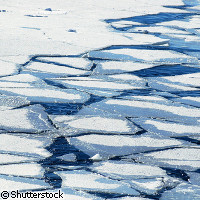Study suggests link between ozone hole and expanding Antarctic sea ice
The hole in the ozone layer is responsible for the growth of Antarctic sea ice, new UK-US research suggests. However, over the coming decades, as the ozone layer recovers and greenhouse gas concentrations rise, this effect is likely to diminish, the scientists warn. 'Understanding how polar sea ice responds to global change - whether human induced or as part of a natural process - is really important if we are to make accurate predictions about the Earth's future climate,' commented Professor John Turner of the British Antarctic Survey. 'This new research helps us solve some of the puzzle of why sea ice is shrinking in some areas and growing in others.' When it reaches its maximum extent at the end of the southern winter, the Antarctic sea ice covers an area of 19 million square kilometres, which is roughly twice the size of Europe. Furthermore, the sea ice extent has been increasing by around 100,000 square kilometres per decade since the 1970s. This is in stark contrast to the situation in the Arctic, where sea ice has dwindled at an alarming rate during the same period. In this latest study, the scientists analysed satellite images and ran computer models to investigate the causes of the changes in the Antarctic sea ice sheet. Their findings, published in the journal Geophysical Research Letters, reveal that changing weather patterns caused by the ozone hole are behind the growth in the region's sea ice. The Southern Ocean is naturally windy, and active depressions regularly ring the Antarctic. The ozone hole acts to strengthen these winds and deepen the storms in the South Pacific area of the Southern Ocean. This in turn increases the flow of cold air over the Ross Sea in West Antarctica, leading to increased ice production in the region. 'Our results show the complexity of climate change across the Earth,' said Professor Turner. 'While there is increasing evidence that the loss of sea ice in the Arctic has occurred due to human activity, in the Antarctic human influence through the ozone hole has had the reverse effect and resulted in more ice.' The ozone hole was discovered in the mid 1980s. It is caused by ozone destroying chemicals called chlorofluorocarbons (CFCs). The nations of the world acted quickly to sign and implement the Montreal Protocol which bans the use of CFCs. However, these chemicals remain in the atmosphere for decades, and so the ozone layer is not expected to recover until the second half of this century. When this happens, wind speeds around the continent will drop and the region will no longer be buffered against the impacts of climate change. 'Although the ozone hole is in many ways holding back the effects of greenhouse gas increases on the Antarctic, this will not last, as we expect ozone levels to recover by the end of the 21st Century,' said Professor Turner. 'By then there is likely to be around one third less Antarctic sea ice.'
Countries
United Kingdom, United States



